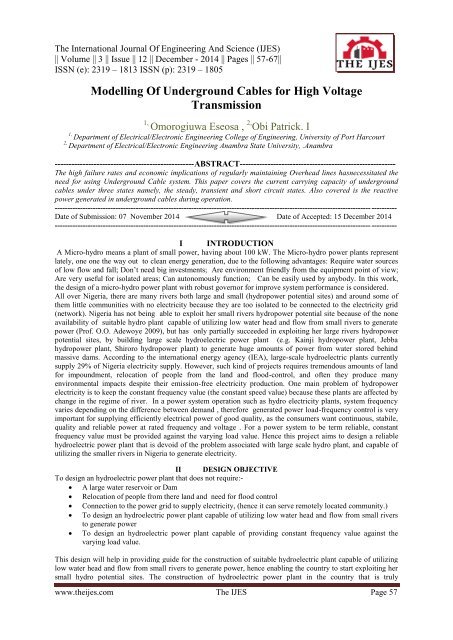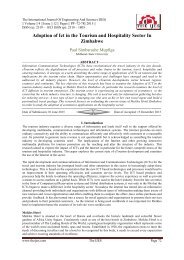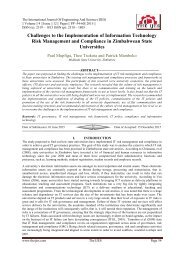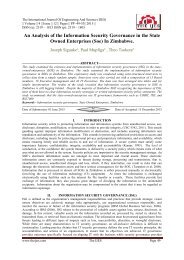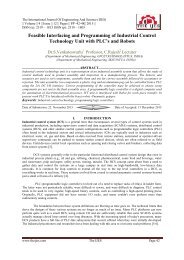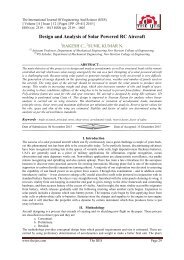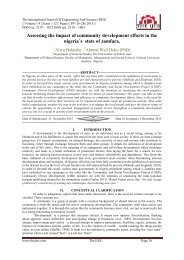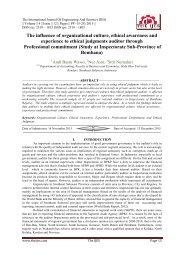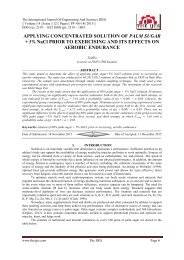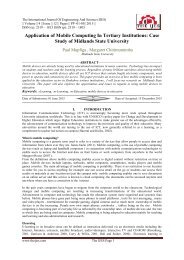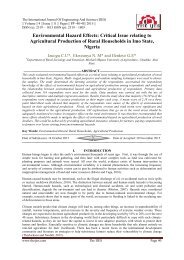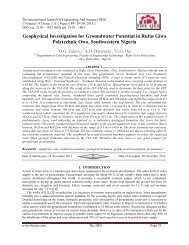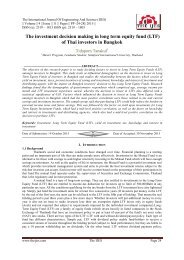Modelling Of Underground Cables for High Voltage Transmission
Create successful ePaper yourself
Turn your PDF publications into a flip-book with our unique Google optimized e-Paper software.
The International Journal <strong>Of</strong> Engineering And Science (IJES)<br />
|| Volume || 3 || Issue || 12 || December - 2014 || Pages || 57-67||<br />
ISSN (e): 2319 – 1813 ISSN (p): 2319 – 1805<br />
<strong>Modelling</strong> <strong>Of</strong> <strong>Underground</strong> <strong>Cables</strong> <strong>for</strong> <strong>High</strong> <strong>Voltage</strong><br />
<strong>Transmission</strong><br />
1,<br />
Omorogiuwa Eseosa , 2, Obi Patrick. I<br />
1,<br />
Department of Electrical/Electronic Engineering College of Engineering, University of Port Harcourt<br />
2,<br />
Department of Electrical/Electronic Engineering Anambra State University, .Anambra<br />
--------------------------------------------------ABSTRACT--------------------------------------------------------<br />
The high failure rates and economic implications of regularly maintaining Overhead lines hasnecessitated the<br />
need <strong>for</strong> using <strong>Underground</strong> Cable system. This paper covers the current carrying capacity of underground<br />
cables under three states namely, the steady, transient and short circuit states. Also covered is the reactive<br />
power generated in underground cables during operation.<br />
----------------------------------------------------------------------------------------------------------------------------- ----------<br />
Date of Submission: 07 November 2014 Date of Accepted: 15 December 2014<br />
----------------------------------------------------------------------------------------------------------------------------- ----------<br />
I INTRODUCTION<br />
A Micro-hydro means a plant of small power, having about 100 kW. The Micro-hydro power plants represent<br />
lately, one one the way out to clean energy generation, due to the following advantages: Require water sources<br />
of low flow and fall; Don’t need big investments; Are environment friendly from the equipment point of view;<br />
Are very useful <strong>for</strong> isolated areas; Can autonomously function; Can be easily used by anybody. In this work,<br />
the design of a micro-hydro power plant with robust governor <strong>for</strong> improve system per<strong>for</strong>mance is considered.<br />
All over Nigeria, there are many rivers both large and small (hydropower potential sites) and around some of<br />
them little communities with no electricity because they are too isolated to be connected to the electricity grid<br />
(network). Nigeria has not being able to exploit her small rivers hydropower potential site because of the none<br />
availability of suitable hydro plant capable of utilizing low water head and flow from small rivers to generate<br />
power (Prof. O.O. Adewoye 2009), but has only partially succeeded in exploiting her large rivers hydropower<br />
potential sites, by building large scale hydroelectric power plant (e.g. Kainji hydropower plant, Jebba<br />
hydropower plant, Shiroro hydropower plant) to generate huge amounts of power from water stored behind<br />
massive dams. According to the international energy agency (IEA), large-scale hydroelectric plants currently<br />
supply 29% of Nigeria electricity supply. However, such kind of projects requires tremendous amounts of land<br />
<strong>for</strong> impoundment, relocation of people from the land and flood-control, and often they produce many<br />
environmental impacts despite their emission-free electricity production. One main problem of hydropower<br />
electricity is to keep the constant frequency value (the constant speed value) because these plants are affected by<br />
change in the regime of river. In a power system operation such as hydro electricity plants, system frequency<br />
varies depending on the difference between demand , there<strong>for</strong>e generated power load-frequency control is very<br />
important <strong>for</strong> supplying efficiently electrical power of good quality, as the consumers want continuous, stabile,<br />
quality and reliable power at rated frequency and voltage . For a power system to be term reliable, constant<br />
frequency value must be provided against the varying load value. Hence this project aims to design a reliable<br />
hydroelectric power plant that is devoid of the problem associated with large scale hydro plant, and capable of<br />
utilizing the smaller rivers in Nigeria to generate electricity.<br />
II DESIGN OBJECTIVE<br />
To design an hydroelectric power plant that does not require:-<br />
A large water reservoir or Dam<br />
Relocation of people from there land and need <strong>for</strong> flood control<br />
Connection to the power grid to supply electricity, (hence it can serve remotely located community.)<br />
To design an hydroelectric power plant capable of utilizing low water head and flow from small rivers<br />
to generate power<br />
To design an hydroelectric power plant capable of providing constant frequency value against the<br />
varying load value.<br />
This design will help in providing guide <strong>for</strong> the construction of suitable hydroelectric plant capable of utilizing<br />
low water head and flow from small rivers to generate power, hence enabling the country to start exploiting her<br />
small hydro potential sites. The construction of hydroelectric power plant in the country that is truly<br />
www.theijes.com The IJES Page 57
<strong>Modelling</strong> <strong>Of</strong> <strong>Underground</strong> <strong>Cables</strong> For <strong>High</strong>...<br />
environment friendly is achieved via better power load-frequency control on hydroelectric power plant in the<br />
country and beyond.<br />
III DESIGN METHODOLOGY:<br />
In this work, micro-hydro power plant, consisting of five elements: water tank and valve, supply<br />
pipe, chain type hydro turbine, generator and controller is considered. The work presents a systemic<br />
approach on Micro-hydro plant, starting with the achievement of block diagram with one control closed loops.<br />
Discussion /analysis, as well as modeling and simulation of the electro mechanical part (hydro turbine,<br />
generator) was considered. The results of this work prove the correctness of this design that could be used in<br />
practical applications. The design is limited to hydro electric power plant <strong>for</strong> use in run-of-river’ scheme and<br />
only the electro-mechanical components of the plant (i.e. the turbine–generator) and the Controller (i.e. the<br />
governor)<br />
IV LITERATURE REVIEW<br />
Hydropower is a renewable, non-polluting and environmentally benign source of energy. Hydropower is based<br />
on simple concepts. Moving water turns a turbine, the turbine spins a generator, and electricity is produced.<br />
Many other components may be in a system, but it all begins with the energy in the moving water. The use of<br />
water falling through a height has been utilized as a source of energy since a long time. (Dilip Singh 2009) It is<br />
perhaps the oldest renewable energy technique known to the mankind <strong>for</strong> mechanical energy conversion as well<br />
as electricity generation. In the ancient times waterwheels were used extensively, but it was only at the<br />
beginning of the 19th Century with the invention of the hydro turbines that the use of hydropower got<br />
popularized. Hydropower was the most common way of electricity generating in the early 20th century.<br />
The first commercial use of hydroelectric power to produce electricity was a waterwheel on the Fox River in<br />
Wisconsin in 1882 that supplied power <strong>for</strong> lighting to two paper mills and a house. Within a matter of weeks of<br />
this installation, a power plant was also put into commercial service at Minneapolis. India has a century old<br />
history of hydropower and the beginning was from small hydro. The first hydro power plant was of 130 kW set<br />
up in Darjeeling during 1897, marked the development of hydropower in the country. Similarly, by 1924<br />
Switzerland had nearly 7000 hydropower stations in use. Even today, Small hydro is the largest contributor of<br />
electricity from renewable energy sources, both at European and world level. With the advancement of<br />
technology, and increasing requirement of electricity, the thrust of electricity generation was shifted to large size<br />
hydro and thermal power stations. However, it is only during the last two decades that there is a renewed interest<br />
in the development of l hydro power projects mainly due to its benefits particularly concerning environment and<br />
ability to produce power in remote areas. Small hydro projects are economically viable and have relatively short<br />
gestation period. The major constraints associated with large hydro projects are usually not encountered in small<br />
hydro projects. Renewed interest in the technology of small scale hydropower actually started in China which<br />
has more than 85,000 electricity producing, hydropower plants. Hydropower will continue to play important role<br />
throughout the 21st Century, in world electricity supply. Hydropower development does have some challenges<br />
besides the technical, economic and environmental advantages it shares above other power generation (fossil<br />
fuel based) technologies. At the beginning of the new Millennium hydropower provided almost 20% (2600<br />
TWh/year) of the electricity world consumption (12900 TWh/year). It plays a major role in several countries.<br />
According to a study of hydropower resources in 175 countries, more than 150 have hydropower resources. For<br />
65 of them, hydro produces more than 50% of electricity; <strong>for</strong> 24, more than 90% and 10 countries have almost<br />
all their electricity requirements met through hydropower. Hydroelectricity is the term referring<br />
to electricity generated by hydropower; the production of electrical power through the use of the gravitational<br />
<strong>for</strong>ce of falling or flowing water. It is the most widely used <strong>for</strong>m of renewable energy. (Wikipedia.com, 2011)<br />
Hydropower is energy from water sources such as the ocean, rivers and waterfalls. Water from the reservoir<br />
flows due to gravity to drive the turbine connected to a generator. Power generated is transmitted over power<br />
lines. Water turbine considered the energy of flowing or falling water into mechanical energy and drives a<br />
generator, which generates electrical power. A control mechanism to provide stable electrical power known as<br />
the governor delivers the power (Bhatti, T.S., Bansal, R.C. and Kothari, D.P 2004).<br />
Hydropower converts the energy in flowing water into electricity. The quantity of electricity generated is<br />
determined by the volume of water flow and the height of "head" (the height from turbines in the power plant to<br />
the water surface) created by the dam. The greater the flow and head, the more electricity produced. A typical<br />
hydropower plant includes a dam, reservoir, penstocks (pipes), a powerhouse and an electrical power substation.<br />
The dam stores water and creates the head; penstocks carry water from the reservoir to turbines inside the<br />
www.theijes.com The IJES Page 58
<strong>Modelling</strong> <strong>Of</strong> <strong>Underground</strong> <strong>Cables</strong> For <strong>High</strong>...<br />
powerhouse; the water rotates the turbines, which drive generators that produce electricity (Working Group on<br />
Prime Movers 1992).<br />
TYPES OF HYDRO POWER PLANT AND CLASSIFICATIONS<br />
(Venkateswaran R. 2003) Hydropower is classified as follow:<br />
• Upto 100KW – Micro Hydro Power<br />
• 101Kw to 2000Kw – Mini Hydro Power<br />
• 2001Kw to 25000Kw – Small Hydro Power<br />
Classifications Based on Head<br />
• Ultra Low Head – Below 3 meters<br />
• Low Head – Less than 40 meters<br />
• Medium/<strong>High</strong> Head – Above 40 meter<br />
(Dilip Singh 2009)Though different countries have different criteria to classify hydro power plants, a general<br />
classification of hydro power plants is as follows:<br />
Current Carrying Capacity <strong>Of</strong> <strong>Cables</strong>: Ampacity in an underground cable system is the capacity of the<br />
installation to extract heat from the cable and dissipate it in the surrounding soil and environment. The maximum<br />
operating temperature of cables is a function of the damage the insulation can suffer as a result of high operating<br />
temperatures. There are three standardized ampacity ratings namely: steady state, transient (or emergency) state,<br />
and short circuit state. In computing the ampacity of cables, both numerical and analytical methods are used. The<br />
numerical approach is mainly based on finite differences of finite elements technique. The finite elements<br />
technique is better suited <strong>for</strong> cable Ampacity because of the round geometry of the cables. The two major<br />
international standards organizations, the IEEE and the IEC both adopt the analytical method as the basis <strong>for</strong> their<br />
standards. In an underground cable system, the main heat transfer mechanism is by conduction with the exception<br />
of the air in the conduit in the duct banks or buried duct installations. The different Ampacity ratings conditions<br />
are considered in the cause of the research.<br />
STEADY STATE AMPACITY RATINGS<br />
The flow of current is usually accompanied by the production of heat. The heat sources in cable installations can<br />
be divided into two generic groups. They are the heat generated in conductors and the heat generated in<br />
insulators. The losses in the conductor element are by far the most significant losses and are caused by :a) Joule<br />
losses due to impressed current, circulating current or induced (eddy current) losses.b) Hysteresis losses in<br />
conductors which are also magnetic. The metallic components of an underground cable that produce heat are the<br />
core conductors, sheaths, concentric neutrals, Armours, Skid wires and pipes or ducts. The losses in these<br />
components are functions of the frequency f, and the temperature of operation and it is proportional to the square<br />
of the applied current. This dependence on frequency and temperature is included in an equivalent AC resistance<br />
to express Joule’s law as<br />
W = R ac ( f , t ) I 2 (1)<br />
Where W represents heat loss through conductor,R ac is the equivalent AC resistance(Ω),f is frequency(Hz), t is<br />
the time in seconds,I represents the current in amperes. Heat is also produced in the insulating material. This<br />
heat produced in the insulating layer is only important under certain high voltage conditions. The loss<br />
relationship is given by W d = G d V 2 = CV 2 tan ( ).Where W d represents heat loss through the<br />
insulation,G d represents geometrical factor of dielectric used. C is the capacitance, V represents voltage<br />
applied, is loss angle. The ampacity calculations under steady state condition is computed using the<br />
Neher-McGrath. This is based on a thermal – electrical analogy method due to Pashkis and baker (1942). The<br />
basic idea is to subdivide the study area into layers. Then one substitutes the heat sources <strong>for</strong> current sources, the<br />
thermal resistances <strong>for</strong> electrical resistances and thermal capacitance <strong>for</strong> electrical capacitance. It is worthy of<br />
note that capacitance has no part in steady state analysis between layers. Thus, the potential difference between<br />
the terminals of the circuits and the innermost current source represents the temperature rise of the core of the<br />
cable with respect to the ambient temperature. There<strong>for</strong>e, the temperature of the cable’s core is the ambient<br />
temperature plus change in temperature. These details are represented below:<br />
c - a = W c (T 1 + T 2 + T 3 ) + W d ( ½ T 1 + T 3 + T 4 ) + W s ( T 3 + T 4 ) (2)<br />
∆W c ( T 1 + ( 1 + ) ( T 3 + T 4 )) + W d ( ½ T 1 + T 3 + T 4 ) (3)<br />
where c represents the Maximum operating Temperature 0 K<br />
a represents the Ambient temperature 0 K<br />
W c represents the heat loss of conductor (I 2 R ac )<br />
W d represents the Dielectric losses W/m<br />
W s represents the Sheath loss W/m<br />
T 1 ,T 3 and T 4 represents the thermal resistances of Insulation, Sheath and Oil ( o Km/W) respectively<br />
www.theijes.com The IJES Page 59
<strong>Modelling</strong> <strong>Of</strong> <strong>Underground</strong> <strong>Cables</strong> For <strong>High</strong>...<br />
In order to derive an expression from which the Ampacity can be computed directly, the heat sources (electrical losses )<br />
W’s are expressed as a proportion of the conductor losses ( W c ). The conductor lossesare computed using the ac<br />
resistance and the current. By substituting the following expressions, we have:W s = W c ,W c = R ac I 2 .Where λ<br />
1<br />
is Sheath<br />
loss factor<br />
For the purpose of simplicity<br />
Let X=( T 1 + ( 1 + (T 3 + T 4 ));Y=( ½ T 1 + T 3 + T 4 ),<br />
W =W d, R ac = R ac I = (4)<br />
From equation (4), we can compute theampacityof an underground cable under steady state condition. <strong>Of</strong> paramount<br />
importance <strong>for</strong> cable rating is the accurate calculation of the thermal resistance T, the loss factor and the AC<br />
resistance R ac of the cable core. The loss factors takes into account the eddy losses induced and the circulating<br />
currents, while R ac considers the temperature dependency of the resistances.<br />
CALCULATION OF THERMAL RESISTANCES<br />
The Thermal Resistivity of the Insulation, the protective covering and the surrounding soil (serving and bedding ) must<br />
be calculated accurately:<br />
Cable Insulation: A careful look at the cross section of the cable, the internal layers have tubular geometries. There<strong>for</strong>e<br />
the thermal resistance of the insulation T 1 is given as<br />
T 1 = In [ π (5)<br />
Where T 1 = Thermal Resistance of the Insulation,g 1 = Thermal resistivity of the Insulation = Radius of Sheath; r =<br />
Radius of conductor. For a multi core cable, the calculation of the thermal resistance is quite difficult due to its<br />
complex thermal field.<br />
b) Protective Covering: The protective covering is also cylindrical in shape. It there<strong>for</strong>e follows that the<br />
thermal resistance will be similar to that of the insulation. The armour thickness is generally very small and can<br />
be neglected. Thus the thermal resistance of the protective covering is given as:<br />
T (2,3) = In [ (6)<br />
Where T (2,3) = thermal Resistance of the protective covering, g2 = Thermal resistivity of the bedding and<br />
serving,R 1 = Radius over the Sheath,R 2 = external radius of the cable,<br />
c) Surrounding Soil: The heat conducted through the cable is passed into the soil. For an underground cable<br />
with external radius R, buried a distance h metres below the ground surface in a soil of constant thermal<br />
resistivity T 4 in 0 C/watt. The thermal resistance of Soil is T 4 and is given by<br />
T 4 = In [ (7)<br />
Where T 4 =Thermal Resistance of the surrounding soil g3 = Thermal resistivity of soil in 0 C/watt,h =depth of<br />
cable in the ground,R 2 =external radius of the cable.From the above equation, it is evident that the depth of<br />
laying of cable affects the Ampacity of an electric cable. Deeper laying means an increased thermal resistance of<br />
the soil (to the surface) hence the cable is de-rated.<br />
CALCULATION OF LOSS FACTOR<br />
Loss factor in equations6 and 7 relates the losses that metallic layer such as Sheath, armour etc produce in<br />
proportion to the Cable core. These losses are due to induced (eddy’s) current and circulating currents. The<br />
geometrical arrangements are diverse and some are quite complicated. The bonding used <strong>for</strong> the Sheaths plays a<br />
vital role in the current intensity that circulates in them. Thus the losses are very much dependent on the<br />
bonding type and the geometrical arrangement of the cables (flat or triangular).A cable has a capacitance<br />
between the core and the sheath. When a voltage is applied to an unloaded cable, a capacitive current (or<br />
charging current) flows. Since the resistivity of the insulation is not infinite, leakage current flows and a power<br />
loss occurs. With ac voltages, the phenomenon of dielectric absorption also contributes to the power loss. Thus,<br />
a cable acts as an imperfect capacitor and the total current, under loaded conditions, leads the voltage by an<br />
angle of (90 – δ). The angle δ is termed the loss angle of the dielectric. The dielectric loss P d is<br />
P d = VI cos φ = VI sin δ = CV 2 sin<br />
Where C = capacitanceV= line to neutral voltage, angular velocity,frequency=2 f=100<br />
<br />
A.C RESISTANCE<br />
www.theijes.com The IJES Page 60
<strong>Modelling</strong> <strong>Of</strong> <strong>Underground</strong> <strong>Cables</strong> For <strong>High</strong>...<br />
The operating resistance of a cable is a function of the temperature and the frequency. The temperature variation<br />
is described by:R(t) = R 0 [ 1 + ά ( t – t 0 )] (9)<br />
Where :R 0 = Resistance at a base temperature ( t 0 = 20 0 C )<br />
ά=Coefficient of variation with temperature.Although there exists an analytical expression using Bessel function<br />
<strong>for</strong> modelling of eddy current at low frequencies ( 50 Hz), these are very simple and accurate <strong>for</strong>mulas adequate<br />
<strong>for</strong> ampacity calculations. The eddy’s current effects are included by two factors. One considers the skin effect<br />
(y s ) and the other, the proximity effect (y p ). The mathematical expression to account <strong>for</strong> these losses is:<br />
R(f) = R dc (1+ y s + y p ) (10)<br />
Combining both equations (9 and 10),<br />
R ac ( t, f ) = R 0 [1 + ά ( t – t 0 )]( 1+ y s + y p ) (11)<br />
The values y s and y p are computed from simplified analytical expression particular to each cable core<br />
construction (solid, stranded segmented, etc).<br />
Considering a 362kV, 10 km long, 3-core aluminium conductor with XLPE insulation laid in direct burial<br />
method at a depth of 1.3m below the ground with the following data:<br />
Laying Condition: 3 foil <strong>for</strong>mation, Direct burial method.<br />
Cable depth in ground = 1.3m, Soil thermal resistivity = 1.2k.m/W,Soil temperature (ambient) = 20 0 C<br />
Nominal sectional area = 1600mm 2 (segmental stranded),Conductor diameter = 48.9mm,Thickness of Insulation<br />
= 22.4mm,DC resistance of the conductor core at 20 0 C = 0.0186Ω/km,Sectional area of aluminium screen =<br />
290mm 2 ,Outside diameter of cable = 120mm,Increase in resistance due to skin effect = 3.5 per cent<br />
Increase in resistance due to proximity effect = 3.5% Resistivity of aluminium at 20 0 C =0.02826 x 10 -6 Ω/m<br />
Temperature coefficient of resistance = 0.004per 0 C<br />
Increase in resistance due to stranding and laying =2% Sheath loss = 10% of conductor loss.<br />
Computing the steady state Ampacity rating using the above data is carried out as follows: Conductor<br />
resistance=<br />
=1.766 x 10 -5 ohm/m. Allowing <strong>for</strong> increase in resistance due to stranding<br />
and laying; R dc at 20 0 C = 1.02 x1.02 x 1.766 x 10 -5 = 1.83735 x 10 -5 ohm/m, R dc at 90 0 C = 2.3518 x 10 -5 ohm/m.<br />
Allowing <strong>for</strong> increase in resistance due to proximity effect and skin effect; R ac = 1.035 x 1.035 x 2.3518 x 10 -<br />
5 .Total insulation thickness = 22.4mm . Ratio of total insulation thickness to core diameter = = 0.458.Thermal<br />
resistance per core per metre = 0.65 ohm/m . There<strong>for</strong>e <strong>for</strong> a 3-core cable, Thermal resistance (T 1 ) = = 0.217<br />
ohm/m . T 2,3 = In = 44.2393 In (1.0435) = 1.8828 ohm/m .<br />
Soil thermal resistance (T 4 ) = In = 0.15913 In 43.3 = 0.5993ohm/m . W d = dielectric loss is derived<br />
from the equation:<br />
W d = 3 (Vo) 2 C tan δ,V0 is the operating voltage to neutral = 362,000 / = 209,000 V =<br />
209kV,f = 100 C = = (2 r 0/In x L),R = (11.2 x 10 -3 ) + (24.45 x 10 -3 ) = 0.0112 + 0.02445 =<br />
0.0357,R = 24.45mm = 0.02445m<br />
There<strong>for</strong>e C = = = 14.553 x 10 -15 F<br />
tanδ= dielectric loss factor = 0.004<br />
Applying equation 9,<br />
I W d = 3 x (209000) 2 x 100π x 14.553x10 -14 x0.004=0.0024=<br />
I =<br />
= 981.7269 [A].<br />
There<strong>for</strong>e the steady state Ampacity rating <strong>for</strong> the cable is 981.7269 [A].The relationship between any given<br />
parameter and the Ampacity is studied by assuming the parameter to be studied and the Ampacity as unknowns<br />
while other quantities are calculated and applied in the Ampacity equation. This brings out an equation showing<br />
the relationship between the Ampacity and the parameter in question. The relationship between these parameters<br />
and the Ampacity are plotted <strong>for</strong> the two kinds of conductors used (aluminium and copper) each with three<br />
different types of Insulators namely XLPE, Polyvinyl Chloride and oil impregnated paper thus resulting in six<br />
graphs per parameter. The graph is plotted <strong>for</strong> various values of the parameter using Matlab. The relationships<br />
are shown.<br />
Ambient Temperature : The relationship between ambient temperature and Ampacity <strong>for</strong> XLPE insulated<br />
cable is shown:<br />
XLPE insulated cable with Aluminium conductor:<br />
I =<br />
where Ambient Temperature<br />
www.theijes.com The IJES Page 61
<strong>Modelling</strong> <strong>Of</strong> <strong>Underground</strong> <strong>Cables</strong> For <strong>High</strong>...<br />
The values of I is computed <strong>for</strong> various values of using Matlab and the graph plotted. The output of the<br />
graph is shown in figure 1.0:<br />
Fig1.0 Cable Ampacity vs Ambient Temperature <strong>for</strong> XLPE with aluminium conductor<br />
XLPE insulated cable with copper conductor: For copper conductor, the relationship between the ampacity<br />
and the ambient temperature and its plot is shown in figure 2.0:<br />
I =<br />
Fig 2.0 Graph of Ampacity vs Ambient temperature <strong>for</strong> XLPE insulated copper conductor cable<br />
For Polyvinyl Chloride Insulator: For Aluminium Conductor : The relationship between the Ampacity and<br />
the Ambiet temperature and its graph is shown below:I =<br />
Graph of Ampacity vs Ambient temperature <strong>for</strong> PVC with Aluminium conductor<br />
Copper conductor with PVC insulation:The relationship and the graph are shown in figure 3.0<br />
I =<br />
www.theijes.com The IJES Page 62
<strong>Modelling</strong> <strong>Of</strong> <strong>Underground</strong> <strong>Cables</strong> For <strong>High</strong>...<br />
Fig 3.0 Graph of ampacity vs ambient temperature <strong>for</strong> PVC insulation with copper conductor<br />
Oil Impregnated Paper dielectric: The relationship between the ampacity and ambient temperature <strong>for</strong> each of<br />
the two different types of conductor using paper dielectric is shown in figure 4.0<br />
Aluminium Conductor: The relationship and the graph is shown below:<br />
I =<br />
Fig 4.0 Graph of ampacity vs Ambient Temperature <strong>for</strong> Paper Dielectric using aluminium<br />
Copper Conductor: The relationship and the graph <strong>for</strong> a paper insulated cable <strong>for</strong> ampacity against ambient<br />
temperature is shown in figure 5.0<br />
I =<br />
Fig 5.0 Graph of ampacity vs abient temperature <strong>for</strong> paper insulated copper conductor cable<br />
Conductor Temperature : As shown from the Ampacity calculations, the relationship between the Ampacity<br />
rating of underground cables and the Conductor temperature <strong>for</strong> Aluminium and Copper Conductors<br />
respectively are;<br />
Aluminium:<br />
I =<br />
where Conductor Temperature<br />
The values of I is plotted <strong>for</strong> various values of and the graph showing this relationship is shown in figure<br />
6.0<br />
www.theijes.com The IJES Page 63
<strong>Modelling</strong> <strong>Of</strong> <strong>Underground</strong> <strong>Cables</strong> For <strong>High</strong>...<br />
Fig 6.0 Graph of Cable Ampacity vs Core temperature with Aluminium conductor<br />
For Copper Conductor: The relationship and its graph is shown in figure 7.0<br />
I =<br />
Fig 7.0 Graph of Ampacity vs copper conductor core temperature<br />
For Dielectric loss: The effect of dielectric losses on Ampacity is studied <strong>for</strong> XLPE insulation with each of the<br />
two conductors i.e. aluminium and copper conductors. The relationship and the plot of Ampacityvs dielectric<br />
loss <strong>for</strong> each of the different dielectric is shown in figure 8.0 and 9.0 respectively<br />
FOR ALUMINIUM CONDUCTOR:<br />
I =<br />
Fig 8.0 Graph of Ampacity vs Dielectric loss <strong>for</strong> Aluminium Conductor<br />
Copper Conductor: The relationship and the graph of Ampacity vs. dielectric loss <strong>for</strong> a copper conductor<br />
XLPE insulated cable is shown below:<br />
I =<br />
www.theijes.com The IJES Page 64
<strong>Modelling</strong> <strong>Of</strong> <strong>Underground</strong> <strong>Cables</strong> For <strong>High</strong>...<br />
Fig 9.0 Graph of Ampacity vs Dielectric loss <strong>for</strong> copper conductor, XLPE insulated cable<br />
<br />
TRANSIENT STATE : The insulators are weakened as a result of over voltage surges in transmission<br />
lines. This is majorly noticed when XLPE insulated cables are used <strong>for</strong> underground cabling. This<br />
eventually results in cable failure. However ,in ensuring that this failure does no happen, the insulator<br />
breakdown as a result of temperature rise should there<strong>for</strong>e be computed in order to determine the overvoltage<br />
ratings of such cables.The rise in core temperature and time duration of over-current should be<br />
known to calculate the over-current rating and it depends on their thermal conditions.<br />
<br />
SHORT CIRCUIT RATING : According to Jean-Pierre in Nexans publication (2004), Short circuit<br />
current in an electrical network are as a result of the accidental connection of one or more phase<br />
conductors, either together, or with the ground. There are two types of short circuit currents namely:<br />
Symmetrical Short Circuits (3 phase short circuits) where the currents in the three phases <strong>for</strong>m a<br />
balanced system. These currents there<strong>for</strong>e only circulate in the conductor (cores) of the cable.Zero<br />
Sequence Short Circuits result from an unsymmetrical i.e. unbalanced current system. Zero sequence<br />
currents return via the ground and/ or by the conductors that are electrically parallel to the ground.<br />
These conductors are mainly ground conductors, metallic screens connected to the ground at the line<br />
termination or ground itself. Under short circuit conditions, the current flowing in the cable is many<br />
times the full load value of the current. Heat produced in the conductor is proportional to the square of<br />
the current.The safe value of limiting temperature is usually taken as 120 0 C. For a maximum<br />
continuous operating conductor temperature of 50 0 C and a permissible temperature rise of 20 0 C during<br />
Short Circuit, the approximate <strong>for</strong>mula may be given as I SC =<br />
Where I SC = Short Circuit rms value<br />
of the current, A = Cross-sectional Area of the conductor, t = Duration of Short Circuit (seconds), K<br />
= A constant (The value of the constant depends on the rise of temperature).If the amount of heat<br />
generated in a cable is equal to that dissipated, a thermal equilibrium is reached. For satisfactory<br />
operation of the cable, the operating temperature should be lesser than the permissible maximum<br />
temperature. In case the amount of heat generated is more than the dissipated, the cable temperature<br />
goes on rising till a<br />
thermal breakdown occurs when the insulation is damaged. Thus there’s a need <strong>for</strong> protection of underground<br />
cables against Transient Over-<strong>Voltage</strong>s and Short Circuit current.<br />
EFFECTS OF SHORT-CIRCUIT CURRENTS ON EQUIPMENT<br />
Thermal effects : Short-circuit currents flowing through conductors of various power system equipment create<br />
thermal effects due to heating and excess energy input over time as measured by I 2 T.Where Iis short-circuit<br />
current magnitude and T, short-circuit current duration. The heat loss from conductors during isalso very low.<br />
Generally, both ac and dc components of short-circuit current contribute to thermal heating of conductors..<br />
During the making of high short-circuit currents by inadequately rated circuit-breakers, their contacts may weld<br />
together encouraged by a pre striking flashover arc and possibly contact popping.<br />
<br />
Mechanical Effects : Short-circuit currents flowing through conductors of various power system<br />
equipment create electromagnetic <strong>for</strong>ces and mechanical stresses on underground cables. The<br />
electromagnetic <strong>for</strong>ces produced by short-circuit currents in three-core unarmored cables tend to repel<br />
the cores from each other and could burst the cable altogether leading to insulation damage if the cores<br />
are not adequately bound.<br />
www.theijes.com The IJES Page 65
<strong>Modelling</strong> <strong>Of</strong> <strong>Underground</strong> <strong>Cables</strong> For <strong>High</strong>...<br />
POWER GENERATED IN AN UNDERGROUND CABLE<br />
Reactive power is a concept used to describe the background energy movement arising in Alternating Current (AC)<br />
system due to production of electric and magnetic fields. These fields store energy which changes through each AC<br />
cycle. Reactive power flows can give rise to substantial voltage changes across the system thus it is necessary to maintain<br />
reactive power balancesbetween the sources of generation and the point of demand on zonalbasis. <strong>Underground</strong> cables,<br />
when operating at normal system voltage produce strong electric field and so generate reactive power. When current<br />
flows through a cable, it produces magnetic fields which absorb reactive power. The reactive power generated by electric<br />
field in underground cables is always greater than the reactive power absorbed by the magnetic field. Thus, the<br />
underground cable is a net generator of reactive power.Since the single core cable has an earthed metallic sheath, there is<br />
an electric field between the conductor core and the sheath. Let the charge on the surface of the conductor be q coulomb<br />
per metre length of cable. The electric flux density at a radius x is<br />
D x = C/m 2 12<br />
The electric field intensity E x at a radius x isE x = D x ╱ r 0 = q/2∏ r 0x V/m 13.<br />
Where r is the relative permittivity (dielectric constant) of the cable insulation and 0 = 8.85 x 10 -12 F/m.The<br />
potential difference between the core and the sheath is<br />
V =∫ r R E x dx = (q/2∏ r 0)(In ) volts 14<br />
Capacitance between the conductor core and sheath is<br />
C = = (2∏ r 0/In ) F/m 15<br />
An underground cable has high capacitance which results in charging current and reactive power. If V is the line<br />
to line voltage, the charging current I c is<br />
I c =2 fCV/ 16<br />
This there<strong>for</strong>e implies that the 3-phase reactive power is VI c . Applying equation 16<br />
Reactive power = VI c = V (2∏fCV/ [2∏ r 0/In<br />
= 4 2 f V 2 r 0/[In (R/r)] vars/m 17<br />
The flow of charging current causes heating of the cable. There<strong>for</strong>e, the load current capability of the<br />
underground cable is decreased (i.e. derating occurs) if the temperature rise is not exceeded.<br />
VI<br />
RESULTS OF RESEARCH<br />
The Steady state Ampacity rating of an underground cable is derived and it is given as:I =<br />
Where<br />
X = ( T 1 + ( 1 + (T 3 + T 4 )) Y= ( ½ T 1 + T 3 + T 4 ),W = W d ,R = R ac , = c a,,<br />
c =Conductor temperature a =Ambient temperature. Due to the economic implications of underground cable<br />
failures, it is important to study the different parameters that directly or indirectly affect the Ampacity rating of<br />
an <strong>Underground</strong> Cable. The following results have there<strong>for</strong>e been deduced:<br />
Ambient Temperature: The research shows that the ambient temperature is inversely proportional to the<br />
Ampacity rating of an <strong>Underground</strong> Cable in the steady state irrespective of the type of conductor (whether<br />
copper or Aluminium used).For all the graphs plotted, it is clear that irrespective of the type of insulation, the<br />
Ampacity of a copper conductor is always higher than that of an Aluminium conductor.<br />
Conductor Temperature: The conductor core temperature is directly proportional to Ampacity of an<br />
underground cable. It can further be deduced that,<br />
Insulation Resistance. The insulation resistance of a dielectric is inversely proportional to the Ampacity of an<br />
<strong>Underground</strong> Cable. This there<strong>for</strong>e means that the higher the Ampacity, the lesser the Insulation resistance.<br />
Cable Depth In Soil (<strong>for</strong> direct burial method): The cable depth in soil is inversely proportional to the<br />
Ampacity rating of the <strong>Underground</strong> cable. The higher the depth value is, the lower the Ampacity of the cable.<br />
Transient State And Short Circuit State Condition: In the event of a switching over-voltage (transient state)<br />
and a short circuit fault ( short circuit condition) the insulator must be able to withstand the rapid temperature<br />
rise accompanied by these occurrences without the insulator degrading so as to eliminate that cause of<br />
underground cable failure<br />
The reactive power generated in underground cables is accompanied by the flow of charging current which<br />
causes heating of the underground cable. The insulator should be able to withstand the amount of heat produced<br />
without degrading so as not to result in failure of the <strong>Underground</strong> Cable.<br />
www.theijes.com The IJES Page 66
<strong>Modelling</strong> <strong>Of</strong> <strong>Underground</strong> <strong>Cables</strong> For <strong>High</strong>...<br />
VII<br />
CONCLUSION<br />
The study of the behaviour of underground cables in the steady, transient and short circuit states gave so much<br />
insights into the behaviour of underground cables under these conditions. The knowledge of the main cause of<br />
<strong>Underground</strong> cable failure which is the failure of the dielectric or the insulating material due to excessive heating<br />
of the cable was covered. In order to reduce failure rates of underground cables, the design and construction of<br />
cables should be such that it operates within acceptable temperature limits during each of the steady, transient<br />
and short circuit conditions. Also the effect of the environment (which includes the surrounding soil where the<br />
cable is to be laid ). All the various aspects of this research should there<strong>for</strong>e be considered during the design of<br />
cables in order to get the desired output.<br />
VIII RECOMMENDATION: Although the cost of installation of underground cable system is very high<br />
compared to the equivalent cost of installing an overhead transmission line system, the underground cable has a<br />
far higher reliability than the overhead line. The underground cable system also has a lesser failure rates and<br />
outages compared to the overhead line system. With the ever growing Nigerian population and the recent<br />
intention of the federal government of Nigeria to increase the primary transmission voltage from 330kV to 750<br />
kV, the use of <strong>Underground</strong> cables <strong>for</strong> the transmission of this 750 kV will be a good and economical option<br />
The use of 750kV in overhead line will pose too much risk to lives and properties as they are exposed to<br />
increased radiation. Most importantly, they are also at serious risk of electrocution if the air between the<br />
overhead line and the ground is ionized as a result of the extremely high voltage. Alternatively, with the<br />
<strong>Underground</strong> cable system, the failure rates are highly reduced thus far lower outages, they last longer than<br />
overhead transmission lines, underground cables can be passed through residential areas without posing any risk<br />
to the people and animals living in that area<br />
REFERENCES<br />
[1] American Electric Power, “Important Factors Affecting <strong>Underground</strong> Cable Placement of <strong>Transmission</strong> Facilities”, May 2007.<br />
[2] Faruk, A., et al “Computer Assisted Teaching of <strong>Underground</strong> Power <strong>Cables</strong> (POWCABGUI) <strong>for</strong> Graduate Students”, p 1-7,<br />
September 2009.<br />
[3] Francisco, D.”Calculation of <strong>Underground</strong> Cable Ampacity”, CYME International T&D, September 2005.<br />
[4] Keith, M., “ELEC 5205- <strong>High</strong> <strong>Voltage</strong> Engineering”, University of Sydney, March 2008.<br />
[5] Johan, E., “<strong>Underground</strong> <strong>Cables</strong> in <strong>Transmission</strong> Networks”. May 2005<br />
[6] Nexans <strong>High</strong> <strong>Voltage</strong> <strong>Underground</strong> <strong>Cables</strong>, “60-500kV <strong>High</strong> <strong>Voltage</strong> <strong>Underground</strong> Power <strong>Cables</strong>, XLPE insulated cables”, August<br />
2004.<br />
[7] Transpower New Zealand LTD, “Comparison of Reliability of a 400kV <strong>Underground</strong> Cable with an Overhead Line <strong>for</strong> a 200km<br />
Circuit”, p 1-6, March 2005.<br />
[8] Unnur, S., et. Al “Measurement <strong>for</strong> validation of high voltage <strong>Underground</strong> Cable <strong>Modelling</strong>”, p 1-2,March 2009.<br />
www.theijes.com The IJES Page 67


